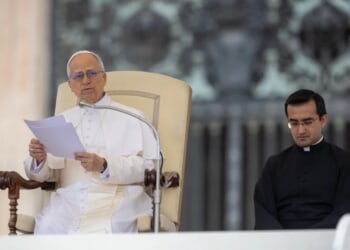Considering this action and China’s support of the Houthis, the Saudi royal family should think twice about getting too cozy with Beijing.
Back on April 24, 2025, I authored an article for The National Interest discussing how the People’s Republic of China (PRC) was waging a proxy war on the United States of America via the Houthi terrorist group in Yemen, more specifically by supplying the Houthis with satellite imagery intelligence that aids the Islamic extremists in targeting shipping in the Red Sea.
I also reported therein that the PRC is trying to play both sides of the fence, expanding the presence of its Belt and Road Initiative (BRI) in the Kingdom of Saudi Arabia (KSA), which happens to be a sworn enemy of the Houthis, having started its own military campaign against the Houthis in 2015, nearly an entire decade before the United States and Great Britain did so.
And now China has evidently taken a more direct against American military assets in the KSA, an act which didn’t involve any shots fired and, therefore, didn’t serve as a casus belli but could still be construed as a belligerent act.
China’s Game in Saudi Arabia
The news of this incident comes to us via reporter “MAL” of essanews.com in an article republished on MSN on or about May 23, 2025, titled “Chinese jet buzzes US carrier near key Saudi Arabia port.” To wit:
“A J-10C fighter jet from China was photographed flying at a low altitude near King Fahd Port in Yanbu, Saudi Arabia. Units of the United States Navy, including the nuclear-powered aircraft carrier USS Harry S. Truman, are stationed at the port … For residents of Saudi Arabia and Muslims worldwide, the port is an important religious site. It not only guards the entrance to Medina, a holy city of Islam, but also functions as a vital logistical point in the Middle East … Photos allegedly showing Chinese fighter jets flying overhead were shared on social media. Satellite maps corroborated locations where combat aircraft were reported to be flying.”
To add an extra measure of intrigue to this incident, there’s a possible Sino-Egyptian nexus:
“The Chinese defense ministry categorically denied that the J-10C fighters belong to the People’s Republic of China’s army. They also denied sending any aircraft to Egypt. Western military agencies suggest that Beijing plans to sell Egypt a substantial amount of military equipment, including the mentioned fighters … The 3,730-mile flight aimed to test the aircraft’s capabilities. Defence Security Asia reports that the presence of Chinese fighters in Egypt was verified by footage broadcast by the Chinese television station CCTV. Americans are frustrated with the Egyptian authorities, viewing the potential purchase of equipment from China as ‘a betrayal of a long-standing ally.’”
The J-10 Buzzes the USS Harry S. Truman Aircraft Carrier
The Chengdu J-10 Měnglóng (“Vigorous Dragon”; NATO reporting name “Firebird”) is a fourth-generation fighter jet, making its maiden flight in March 1998 and its official operational debut in 2004. Capable of reaching a max airspeed of Mach 1.8, it bears a passing resemblance to the American-made F-16 Fighting Falcon, aka the “Viper,” but, according to my National Interest colleague Harrison Kass, “was likely modeled from an F-16 knock-off, the IAI Lavi.”
As for USS Harry S. Truman (CVN-75), it is the eighth ship of the Nimitz-class of nuclear-powered carriers, coincidentally commissioned the same year that the J-10 made its maiden flight. This mighty warship displaces 105,600 tons, boasts a crew complement of 3,532 commissioned officers and enlisted sailors in the ship’s company along with an additional 2,480 crew in the air wing, and hosts ninety fixed-wing and rotary-wing assets.
(Alas, the Truman was also the carrier affected in the April 28 incident of the F/A-18 Super Hornet fighter jet falling overboard.)
Saudi Arabia, Egypt, and the Value of U.S. Allies
Regarding Egypt, the phrase “betrayal of a long-standing ally” is no mere hyperbole. U.S. and Egyptian military forces have trained together in the Operation Bright Star joint exercise since 1980, and the two nations joined forces as part of the multinational coalition during the 1991 Persian Gulf War, aka Operation Desert Storm, working hand-in-hand to evict then-Iraqi dictator Saddam Hussein’s forces from Kuwait.
Moreover, Egypt is one of the key foreign military sales (FMS) customers of the aforementioned F-16, having initiated such purchases in 1982 and receiving its most recent batch in 2015. Indeed, Egypt is the world’s fourth-largest buyer of the F-16, with a total of 218 airframes in its air force. If Egypt were to supplant its Vipers with the Vigorous Dragons, this would indeed be quite the sea change in terms of its military relations.
As for Saudi Arabia, it is interesting to see that the United States still has a military presence there, as that presence has been reduced significantly since the 1990s and the first decades of the 2000s (the latter decade being when the Global War on Terror was at its peak). However, even with that greatly reduced American military footprint, the KSA still sees the United States as a key military ally (especially as a supplier of the F-15 Eagle) and trading partner. One might logically think that this, along with China’s support to the Houthis, should give the Saudi royal family second thoughts about getting too cozy with Beijing.
About the Author: Christian D. Orr
Christian D. Orr was previously a Senior Defense Editor for National Security Journal (NSJ) and 19FortyFive. He is a former Air Force Security Forces officer, Federal law enforcement officer, and private military contractor (with assignments worked in Iraq, the United Arab Emirates, Kosovo, Japan, Germany, and the Pentagon). Chris holds a B.A. in International Relations from the University of Southern California (USC) and an M.A. in Intelligence Studies (concentration in Terrorism Studies) from American Military University (AMU). He has also been published in The Daily Torch, The Journal of Intelligence and Cyber Security, and Simple Flying. Last but not least, he is a Companion of the Order of the Naval Order of the United States (NOUS). If you’d like to pick his brain further, you can ofttimes find him at the Old Virginia Tobacco Company (OVTC) lounge in Manassas, Virginia, partaking of fine stogies and good quality human camaraderie.
Image: Fasttailwind / Shutterstock.com
















